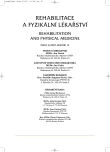The Utilization of Electrical Stimulation in Rehabilitation after Radical Prostatectomy
Authors:
M. Hagovská; P. Takáč
Authors‘ workplace:
Klinika fyziatrie balneológie a liečebnej rehabilitácie LF UPJŠ a FN L. Pasteura, Košice
prednosta MUDr. P. Takáč, Ph. D.
; Fyziatricko rehabilitačné oddelenie, Letecká vojenská nemocnica, a. s., Košice
Published in:
Rehabil. fyz. Lék., 14, 2007, No. 3, pp. 108-113.
Category:
Original Papers
Overview
Prostate carcinoma belongs to the most malignant tumors of the uro -genital system, occurring usually in the fifth to sixth decade of patients life , less frequently also in younger male population. Its incidence is increasing with increasing age. Radical prostatectomy (RAPE) is indicated at an early stage of the disease. Forecast survival rate in such cases in overall good condition is more than 10 years. Frequent later RAPE complications may be stress induced urine incontinence (2-3%) and erectile dysfunction (more than 50%). Rehabilitation treatment was concentrated on relieving the above complications.
The research was carried out within a period of one year. The rehabilitation treatment duration was 4 weeks. The total number of treated patients was 40. The sample of patients was divided into two groups. The first group represented patients who underwent rehabilitation treatment within two years after RAPE and a group of later treated patients who underwent treatment from 2 and more years after RAPE. Early treated patients were 22 and later treated patients were 18. We compared the results in both groups prior to the treatment and after the treatment, and then we compared both groups. We have found significant differences between these two groups in several observed parameters, which gives evidence for contribution of early rehabilitation treatment after radical prostatectomy.
Key words:
radical prostatectomy, urine incontinence, erectile dysfunction, pelvic floor, rehabilitation
Sources
1. AVERY, K., DONOVAN, J., PETERS, T., SHAW, C., GOTOH, M., ABRAMS, P.: ICIQ UI SF: a brief and robust measure for evaluating the symptoms and impact of urinary incontinence. Neurourol Urodyn, 23, 2004, pp. 322–330.
2. BREZA, J. a kol.: Všeobecná a špeciálna urológia. Univerzita Komenského Bratislava, 2004, s. 183–189, s. 200–222.
3. COPTCOAT, M., DOUBLET, J. et.al.: Urological gudelines of laparoscopy. 2004, s. 48.
4. CARDOZO, L.: Urogynecology:the kings approach. New York, Churchil Livingstone, 1997, p. 751.
5. IIEF–5: International index of erectile functiones .
6. INGELMANN-SUNDBERG, A.:Urinary incontinence in women, excluding fistulas. In Acta Obstet. Gynecol. Scand., 31, 1952, s. 266-291.
7. KLIMENT, J., HORŇÁK, M.: Benígna hyperplázia prostaty. Osveta, Martin, 1996, s. 33-39.
8. MAREK, J. a kol.: Symdrom kostrče a panvového dna. Triton, Praha, 2000, s. 45–47.
9. RASMUSSEN, A., MOURITSEN, L., DALGAARD, A., FRIMODT-MOLLER, C.: Twenty-four-hour pad weighing test: Reproducibility and dependency of activity level and fluid intake. Neurourol. Urodyn, 13, 1994, pp. 261–265.
Labels
Physiotherapist, university degree Rehabilitation Sports medicineArticle was published in
Rehabilitation and Physical Medicine

2007 Issue 3
Most read in this issue
- The Importance of Lateral Ankle Joint Ligaments
- Diagnostics of Disorders of Sensor-motor Functions of the Hand in Patients after Ischemic Vascular Event (a Case Study)
- Effects of Rehabilitation in Patients with Disorders of Temporomandibular Joint
- The Utilization of Electrical Stimulation in Rehabilitation after Radical Prostatectomy
